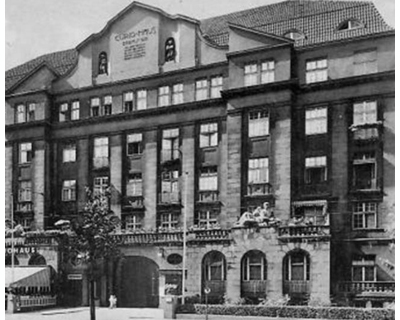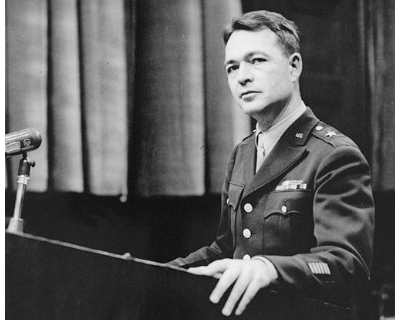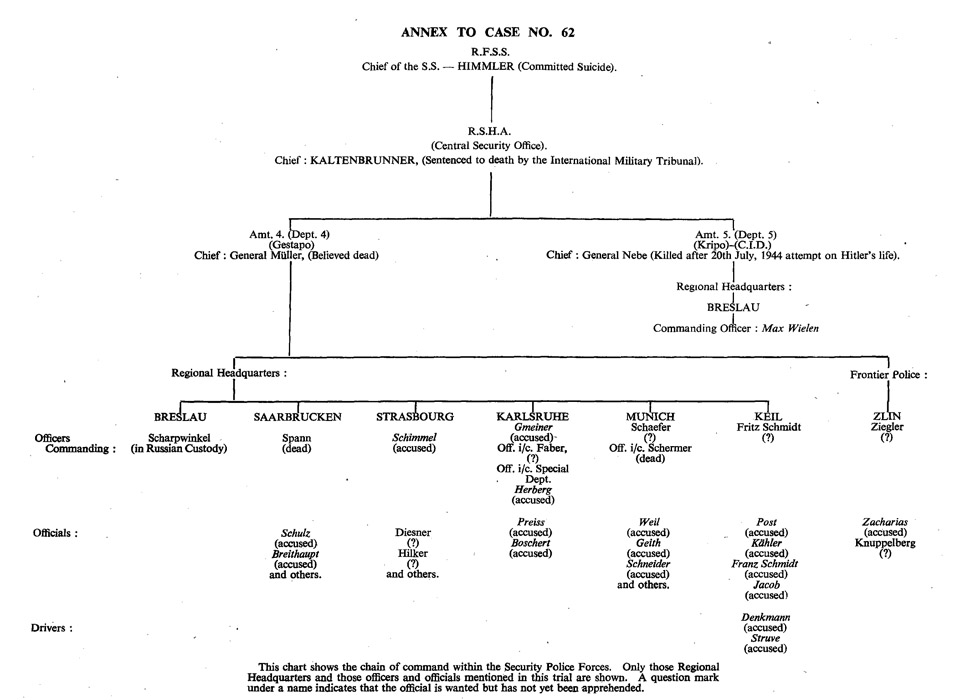The Trial
The trial of those accused of the Stalag Luft III murders began on 1 July, 1947, with eighteen defendants in the dock. The setting was the No. 1 War Crimes Court at the Curio Haus in Hamburg. The accused, made up of various ranks of Gestapo and Kripo officers, all denied the charges ranged against them. Following the conclusion of legal proceedings, the verdicts and sentences were handed down on 3 September of that year. Obersturmbannführer Max Wielen (Breslau Gestapo) was found guilty of conspiracy and sentenced to life imprisonment. Breithaupt (Saarbrucken Gestapo) and Boschert (Karlsruhe Gestapo) received life imprisonment, while drivers Denkmann (Kiel Gestapo) and Struve (Kiel Gestapo) were sentenced to ten years. The remainder were cleared of the first two charges, but found guilty of the seperate charges of murder. All were executed at the Zuchthaus (Jail) in Hamelin during February, 1948.
The most senior officer charged and principal defendant, Max Wielen, was released in 1952 after serving less than five years.

Curio Haus - Military Court, Hamburg

Col. Telford Taylor - Senior Prosecuter
THE CHARGES AND OPENING STATEMENT
CASE NO. 62
TRIAL OF MAX WIELEN AND 17 OTHERS
THE STALAG LUFT III CASE
BRITISH MILITARY COURT, HAMBURG, GERMANY,
1ST JULY-3RD SEPTEMBER, 1947
A. OUTLINE OF THE PROCEEDINGS
1. THE COURT
The court was presided over by a Major-General and consisted of three army officers and three representatives of the Royal Air Force, in accordance with Regulations 5 (1) of the Royal Warrant.(l) (F.O. 81/1945.)
2. THE CHARGES
All the accused were charged with:
(i) Committing a war crime in that they at divers places in Germany and German occupied territory, between 25th March, 1944, and 13th April, 1944, were concerned together and with SS’ Gruppenführer Mueller and SS Gruppenführer Nebe and other persons known and unknown, in the killing in violation of the laws and usages of war of prisoners of war who had escaped from Stalag Luft III.
(ii) Committing a war crime in that they at divers places in Germany and German occupied territory, between 25th March, 1944, and 13th April, 1944, aided and abetted SS Gruppenführer Mueller and SS Gruppenführer Nebe and each other and other persons known and unknown, in carrying out orders which were contrary to the laws and usages of war, namely, orders to kill prisoners of war who had escaped from Stalag Luft III.
The other charges were as follows:
(iii) (Against the accused Emil Schulz and Walter Breithaupt): Committing a war crime in that they between Homburg and Kaiserslautern, Germany, on or about 29th March, 1944, when members of the Saarbriicken Gestapo, in violation of the laws and usages of war, were concerned in the killing of Squadron Leader R. J. Bushell and Pilot Officer B. W. M. Scheidhauer, both of the Royal Air Force, prisoners of war.
(iv) (Against the accused Alfred Schimmel): Committing a war crime in that he in the vicinity of Natzweiler, occupied France, ()n or about 6th April, 1944, when Chief of the Strasbourg Gestapo, in violationof the laws and usages of war, was concerned in the killing of Flight Lieutenant A. R. H. Hayter, Royal Air Force, a prisoner of war.
(V) (Against the accused Josef Albert Andreas Gmeiner, Walter Herberg, Otto Preiss and Heinrich Boschert): Committing a war crime in that they in the vicinity of Natzweiler, occupied France, on or about 31st March, 1944, when members of the Karlsruhe Gestapo, in violation of the laws and usages of war, were concerned in the killing of Flying Officer D. H. Cochran, Royal Air Force, a prisoner of war.
(vi) (Against the accused Emil Weil, Eduard Geith and Johann Schneider): Committing a war crime in that they in the vicinity of Schweitenkirchen, Germany, on or about 29th March, 1944, when members of the Munich Gestapo, in violation of the laws and usages of war, were concerned in the killing of Lieutenant H. J. Stevens and Lieutenant J. S. Gouws, both of the South African Air Force, prisoners of war.
(vii) (Against the accused Johannes Post, Hans Kahler and Artur Denkmann): Committing a war crime in that they in the vicinity of Roter Hahn, Germany, on or about 29th March, 1944, when members of the Kiel Gestapo, in violation of the laws and usages of war, were concerned in the killing of Squadron Leader J. Catanach, D.F.C., Royal Australian Air Force, Pilot Officer H. Espelid, Royal Air Force, Flight Lieutenant A. G. Christensen, Royal New Zealand Air Force, and Pilot Officer N. Fuglesang, Royal New Zealand Air Force, prisoners of war.
(viii) (Against the accused Oskar Schmidt, Walter Jacobs and Wilhelm Struve): Committing a war crime in that they in the vicinity of Roter Hahn, Germany, on or about 29th March, 1944, when members of the Kiel Gestapo, in violation of the laws and usages of war, were concerned in the killing of Pilot Officer H. Espelid, Royal Air Force, Flight Lieutenant A. G. Christensen, Royal New Zealand Air Force, and Pilot Officer N. Fuglesang, Royal New Zealand Air Force; prisoners of war.
(ix) (Against the accused Erich Hermann August Zacharias): Committing a war crime in that he in the vicinity of Moravska-Ostrava, occupied Czechoslovakia, on or about 29th March, 1944, when a member of the Zlin Grenzpolizei, in violation of the laws and usages of war, was concerned in the killing of Flying Officer G. A. Kidder, Royal Canadian Air Force, and Squadron Leader T. G. KirbyGreen, Royal Air Force, prisoners of war.
All the accused pleaded not guilty to the charges brought against them. In the Prosecution’s interpretation, the first two charges were charges of conspiracy against all the accused jointly for participation in the killing of 50 Royal Air Force officers who were shot between 25th March and 13th April, 1944. Charges 1 and 2 were not alternative charges. In charges 3-9 six groups of accused were each charged with the killing of one or several officers of the R.A.F. and Dominion Air Forces. Every accused with the exception of Max Wielen figures in one of these charges, no accused figures in more than one.
On the night of 24th-25th March, 1944, 80 officers of the Royal Air Force and other Allied Air Forces who were prisoners of war at the prisoners of war camp Stalag Luft III at Sagan, in Silesia, escaped from that camp through an underground tunnel. The escape had been carefully planned and the officers, furnished with partly civilian clothes and false papers, fanned out in all directions in an effort to reach the borders of the Reich, mainly France and Belgium in the west, Czechoslovakia in the south and Denmark in the north. 80 officers escaped from the camp through an underground tunnel. Four were recaptured shortly afterwards in the vicinity of the camp, 76 got away. Only 3 of these 76 reached home safely. 15 were returned to Stalag Luft III and 50 were shot by the Gestapo and of the remaining 8, 4 were sent to a concentration camp, 3 were held by the Gestapo headquarters in Czechoslovakia, and of one, the witness had not heard anything at all.
The German authorities were perturbed by the escape, and the Head of the Criminal Police at Breslau, in whose area it had occurred, ordered a “Grossfahndung” in accordance with the regulations on important escapes. This was a nation-wide hue and cry and meant that every policeman and quasi-policeman in Germany and occupied Europe had the task of looking for the escaped officers, whose photographs were published in the German Police Gazette. On 26th March the news of the escape reached Hitler at Berchtesgarten and after consultations with Goering, Keitel and Himmler, he gave the verbal order that “more than half of the escapees were to be shot.” The order was eventually issued from the R.S.H.A. (Reichs SicherheitsHaupt-Amt, the German Central Security Office), by teleprint to the various regional Gestapo headquarters which it concerned. The teleprint itself could not be produced, but in the recollection of the witness Mohr, who had repeatedly dealt with it in his department (Amt 5) at the Central Security Office, it read something like this:
“The frequent mass escapes of officer prisoners constitute a real danger to the security of the State. I am disappointed by the inefficient security measures in various prisoner of war camps. The Führer has ordered that as a deterrent, more than half of the escaped officers will be shot. The recaptured officers will be handed over to Amt 4 for interrogation. After interrogation the officers will be transferred to their original camps and will be shot on the way. The reason for the shooting will be given as ‘shot whilst trying to escape’ or ‘shot whilst resisting’ so that nothing can be proved at a future date. Prominent persons will be exempted. Their names will be reported to me and my decision will be awaited whether the same course of action will be taken.”
The chart at page 52 illustrates the chain of command within the branches of the Central Security Office and the way the order, once given by Himmler, was carried out, can be followed on this chart. It was sent by teleprint to all Gestapo regional headquarters through Amt 4 and to all Kripo (Criminal Police) regional headquarters through Amt 5. It was thus the task of the Kripo (Criminal Police), headed by Amt 5 at the Central Security Office, to apprehend the escaped officers and on recapture to select more than half of them to be handed over to the Gestapo “for interrogation”, i.e. to be shot. It was the task of the Gestapo to take the escaped prisoners of war over from the Kripo and to carry out the shooting. As soon as the news of the recapture of some prisoners of war was reported by the local Kripo to the Central Security Office at Berlin, Amt 5 gave out orders to the Kripo regional headquarters to hand over these prisoners to the Gestapo and Amt 4 gave out orders to the regional headquarters of the Gestapo to take over a certain number of enemy prisoners of war to be shot and to report the killing to Berlin. The orders were given out by teleprint to the Kripo and Gestapo regional offices throughout the country.

